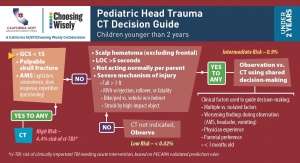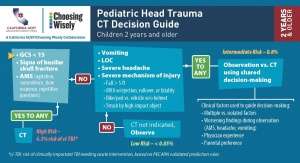PECARN head trauma rule
Rule
This rule was derived from the multicenter PECARN network with both a derivation and validation arm to detect clinically important traumatic brain (ciTBI) injury in children to age 18yrs old after blunt head trauma.
The rule stratifies patients < 2 years old and ≥2 years old.
Rules below are according to the of PECARN Head CT Study[1]
<2 years old

PECARN Under Age 2
Any 1 of the following?
- GCS ≤14
- Altered Mental Status
- Palpable Skull Fracture
Then obtain a Non-Con Brain CT (4.4% risk of cTBI)
1 or more of the following?
- Non-frontal scalp hematoma
- LOC ≥ 5 seconds
- Severe injury mechanism
- pedestrian or bicyclist without helmet struck by motorized vehicle
- fall >1m or 3ft
- head struck by high-impact object
- Abnormal activity per parents
Then consider a Non-Con Brain CT or Observation (0.9% risk of cTBI)
≥2 years old - 18 years

PECARN Age 2 and Up
Any 1 of the following?
- GCS ≤14
- Altered Mental Status
- Signs of a basilar skull fracture
Then obtain a Non-Con Brain CT (4.3% risk of cTBI)
1 or more of the following?
- History of vomiting^
- LOC
- Severe injury mechanism
- Pedestrian or bicyclist without helmet struck by motorized vehicle
- Fall >2m or 5ft
- Head struck by high-impact object
- Severe headache
Then consider a Non-Con Brain CT or Observation (0.9% risk of cTBI)
^Consider observation in place of imaging in children with isolated vomiting (no other indication) as the sole risk factor (0.2% risk of cTBI)[2]
See Also
References
- PECARN Rule Kupperman N, Holmes JF, Dayan PS, et al: Identification of children at very low risk of clinically-important brain injuries after head trauma: a prospective cohort study. Lancet 374(9696): 1160, 2009
- Dayan PS, et al. "Association of Traumatic Brain Injuries with Vomiting in Children with Blunt Head Trauma. June 2014. Annals of EM. 63(6):657-665
This article is issued from
Wikem.
The text is licensed under Creative
Commons - Attribution - Sharealike.
Additional terms may apply for the media files.